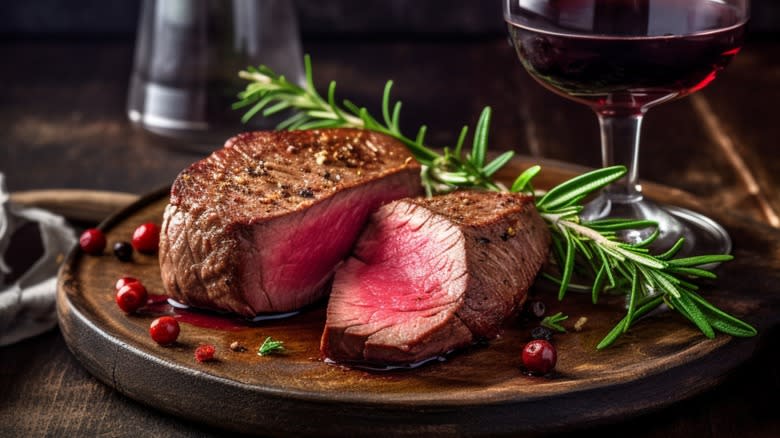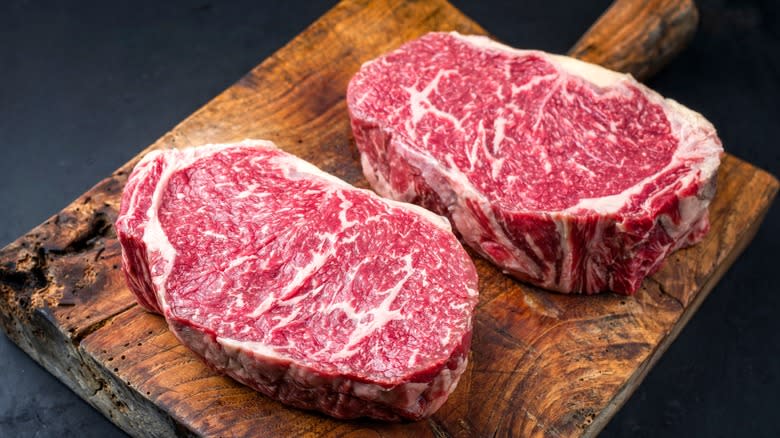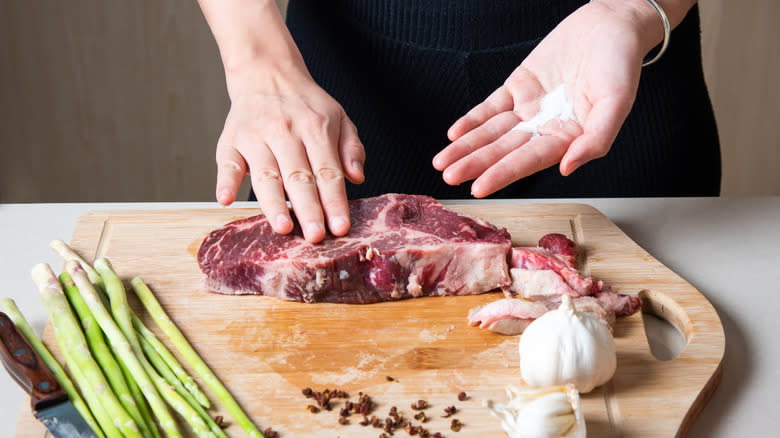The Best Temperature To Cook A Beautiful Piece Of Wagyu

Known for its unusual marbling and unique umami taste, Wagyu beef is a sought-after meat with the highest grade in its class. The beef itself comes from Japanese cows that genetically evolved to maintain excessive fat — or marbling — within their muscle. In turn, this marbling marks the meat as distinct from all other cow breeds. Even if it's only adequately prepared, this genetic anomaly transforms into an exquisite cut of steak world-renowned for its smooth texture and rich flavor. To thoroughly enjoy the incomparable taste of heavy marbling, it is absolutely essential to cook the meat at the appropriate temperature.
Once exclusively placed within the purview of fine dining, Wagyu beef is now more accessible than ever and can be found online or in boutique grocery stores. However, at prices that can often run well over $100 per pound, it's best to treat a cut of Wagyu with the deliberate care and precision it deserves. That means cooking it at the ideal temperature to bring out its mouth-watering taste and unrivaled texture. For Wagyu, that is best achieved with a perfect medium-rare finish.
Read more: The 13 Best Steaks For Grilling
The Optimal Temperature

Before throwing your prized cut on the grill or cast iron, be forewarned: The fat content that gives Wagyu its magical texture will also impact how the meat cooks. A cut of Wagyu will cook up to 30% faster than a traditional American ribeye -- meaning that the temperature you cook Wagyu is intrinsically tied to timing.Speaking with Washington State Magazine, San Francisco-based chef and restaurant owner Fred Reeves emphasizes the importance of a quick cooking time and suggests an optimal temperature. "Wagyu is delicious but needs to be cooked fast because if it's overdone it can taste kind of dry and chewy," he explains. "You want to go with the highest heat you can and get it on and off the cooking surface really quickly." In turn, as a home cook, it's important to mentally prepare for a quick cooking time to nail the medium-rare sweet spot.
The extensive marbling in a piece of Wagyu also creates another issue: grease. When exposed to the hot pan, the impressive fat content in the meat will immediately start rendering. Sizzling fat is great for cooking, but it affects how you prepare the pan before searing. In an interview with the Michelin Guide, Chef Andrea Spagoni offers a tip to Wagyu cooks and suggests that "it is better to use less or no oil or butter to cook" Wagyu to avoid a greasy mess.
How To Prepare Wagyu

Almost as important as the actual heating process is how you prep the meat before cooking. Prior to the main event, make sure to thoroughly thaw the steak in the refrigerator. A frozen interior can quickly ruin the steak when you throw it on a heat source.The Chicago Steak Company recommends thawing the minimum possible amount of time to maintain freshness — about six hours per pound. Before tossing on the grill, the meat should be raised to room temperature. In the Michelin Guide, Chef Curtis Stone notes that "moisture is the enemy to a good sear," and recommends patting the beef dry after it has come to room temperature. When it comes to seasoning, less is more. The Wagyu itself is full of flavor, so a simple seasoning of salt and pepper is sufficient.
Wagyu can be cooked using the same methods you'd use on a traditional steak. Grill, stovetop, or sous vide are all appropriate ways to sear this special cut of meat. When you're finally ready to hear the sizzle of melt-in-your-mouth meat slapped on a blistering cooktop, just remember to pay attention to the timing.
Read the original article on Daily Meal.

